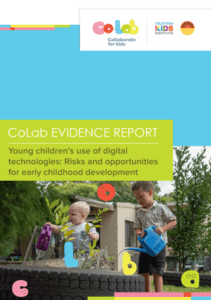How much "tech time" is too much for my child?
Technology has the potential to both enhance and detract from healthy childhood development and learning, depending on how children use it. But how much time on smartphones, tablet, video game consoles, laptops and televisions is too much, and how can we make technology work for our families?
How much "screen time" is appropriate?
Research indicated there is a dose-response association with screen time. As children’s screen time increases, the negative impact on their health, wellbeing and development increases. Therefore, less screen time is better for optimal health [1,2] references
Australia’s Physical Activity and Sedentary Behaviour Guidelines is the official source of evidence-based screen time guidance. The guidelines recommend:
- Children under 18 months old avoid screen technologies, except for video chatting such as Facetime or Skype
- Children between 18 months and two years of age should be supervised by their parents when watching digital technology.
- Children two to five years show have screen time limited to one hour per day and only be used to view high-quality programs.
- Children five to 17 years should use screens for less than two hours per day.
Levels of screen use above these recommendations have been linked to increased risk of obesity, sleep difficulties, anxiety and attention problems and poor performance at schools [4]
On the Plus Side
Technology can be a positive force in our kids’ lives. A 2019 evidence report compiled by the Telethon Kids Institute’s CoLab Project investigated the risks and opportunities for early childhood development associated with the use of digital technologies. They found that when used effectively, technology can promote children’s active engagement and creativity, provide novel learning challenges and promote the development of problem-solving skills. These outcomes can help to lay the foundations for their future cognitive development. However, they stressed that parents need to proactively engage with their children when they are using screen technologies to ensure they benefit from the interaction. For tips on positive use of technology, check out our info on Digital Literacy.
Reality Check
While Australia’s Physical Activity and Sedentary Behaviour Guidelines provide valuable advice for parents, they may not always be realistic when technology use is so embedded in daily life.

As a result, the latest thinking on screentime recommendations shies away from any definitive figures and steers towards a more holistic definition. The Australian Office of the eSafety Commissioner advises the right amount of screen time can depend on your child’s age and maturity, the kind of content they are consuming, their learning needs and your family routine. The quality and nature of your children's activity online, and your involvement, are just as important as focusing on the clock. Instead, ask yourself, is my child:
- Sleeping enough?
- Physically healthy?
- Engaged with school?
- Connecting socially with family and friends, online and offline?
- Enjoying a variety of hobbies and interests?
- Having fun and learning while using screens?
- Using quality content?
If you answer yes to most or all of these questions, your child is probably using screens in a balanced way as part of a healthy lifestyle [7]. However, if you have concerns, it may be useful to consider ways to reduce, replace and balance screen time.
Top Tips
- Less screen time is better for children's optimal health.
- The activities children undertake while using technology matters more than the amount of time they spend using it.
- Children need to be supported and guided by their parents when using screen media.
- Parents who actively engage with their child during screen time can help them understand what they are viewing and its relevance to the world around them.
References
[1] Stiglic N, Viner RM. Effects of screentime on the health and well-being of children and adolescents: a systematic review of reviews. BMJ open. 2019;9(1):e023191.
[2] Carson V, Hunter S, Kuzik N, Gray CE, Poitras VJ, Chaput J-P, et al. Systematic review of sedentary behaviour and health indicators in school-aged children and youth: an update. Applied Physiology, Nutrition, and Metabolism. 2016;41(6):S240-S65.
[3] Holloway, D., Green, L. and Livingstone, S. (2013). (2013). Zero to eight. Your children and their internet use. LSE, London: EU Kids Online, 10(1). doi:10.1186/1479-5868-10-137
[4] Telethon Kids Institute, ‘What you need to know’ guide for parents on the impacts of excessive screen time highlighting new and relevant research.
[5] Marsh, J., & Yamada-Rice, D. (2013). Early literacy development in the digital age. Best Practices in Early Literacy Instruction, 79–95.
[6] McClure, E. R., Chentsova-Dutton, Y. E., Barr, R. F., Holochwost, S. J., & Parrott, W. G. (2015). “Facetime doesn’t count”: Video chat as an exception to media restrictions for infants and toddlers. International Journal of Child-Computer Interaction, 6, 1–6.doi:10.1016/j.ijcci.2016.02.002
[7] Dr Joanne Orlando, K. H. (2019, April 04). Screen time: checklist for healthy use.


